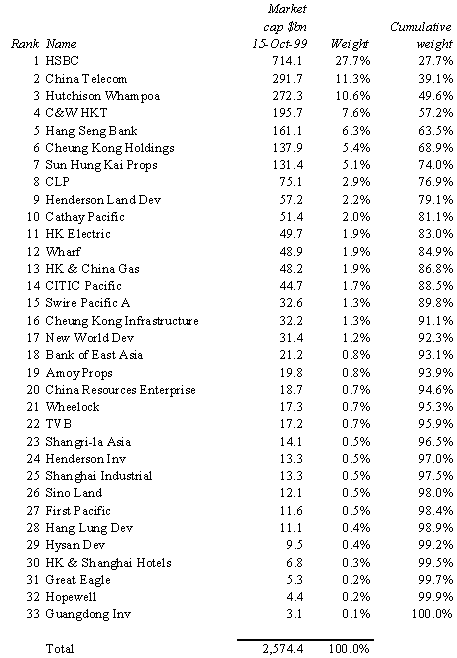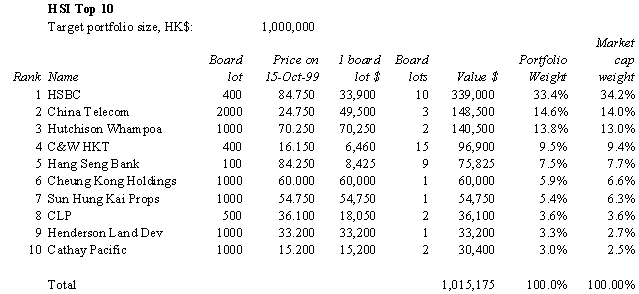The Outdated HSI
19 October 1999
Largely as a result of targeting sellers of the Hang Seng Index, the Hong Kong Government in last year's market intervention ended up with a portfolio very similar to the index. It is now trying to make a virtue of that by packaging up part of its holdings in an HSI-tracking fund, The Tracker Fund of Hong Kong (TraHK).
The Hang Seng Index, in professional eyes, has the standing of the Dow Jones Industrial Average - famous, much talked about, but out-dated. Almost no serious fund manager compares (or "benchmarks") the performance of their Hong Kong portfolio against the HSI. Most use a more relevant index such as the MSCI or the FT/S&P Hong Kong indices. Similarly, U.S. fund managers look at indices like the Standard & Poors 500 rather than the 30 stocks of the DJIA.
A look at the composition of the HSI will tell you what's wrong. Its largest component is a company registered in England with about half of its business outside Hong Kong. HSBC Holdings plc is now a global firm which happens to own The Hongkong and Shanghai Banking Corporation, our largest bank. Many of HSBC's shareholders are in the UK, where the shares were issued in the early 1990s in exchange for Midland Bank plc. That deal put HSBC into the FTSE-100 index, which puts the firm in the unique position of being in two flagship indices at the same time. Since then, HSBC has gone on to expand all over the world. It's time to face the fact that it is no longer a "Hong Kong" company. Perhaps that's why they are rushing around rebranding everything with initials. The MSCI and FT/S&P Hong Kong indices exclude HSBC for similar reasons.
HSBC also owns some 62% of Hang Seng Bank, which owns and publishes the Hang Seng Index.
Here's our estimate of the composition of the HSI, based on closing prices on Friday 15-Oct-99:

Some diversification!
The table above shows that HSBC accounts for 27.7% of the Hang Seng Index, and it subsidiary Hang Seng Bank accounts for another 6.3%. That's over a third of it between them.
You will also notice that the top 10 stocks amount to over 81% of the HSI. Stocks have a tendency to move together (what professionals call "correlation") and therefore if you can hold the vast majority of the weight of the index you will get a portfolio that is highly correlated with the index itself. The other 19% won't make a huge difference. Therefore if you had HK$1m to invest and really wanted to track the index (we can't think why) you could get pretty close just by buying the top 10. We'll show you how that's done later in this article.
The TraHK promotional leaflet says that it provides "diversification across the companies that comprise the HSI". That circular statement would of course be true even if the index only contained one stock. It's like saying that chocolate provides all the nutritional benefits of chocolate's ingredients. Do not take it to mean that chocolate is good for you.
In fact, the SFC does not normally authorise mutual funds for sale to the public unless they contain a restriction limiting them to not more than a 10% portfolio weighting in any one stock. The TraHK must have obtained a waiver of this (which the SFC allows under its code) since the top 3 HSI stocks are each greater than 10% and add up to nearly 50% of the entire portfolio. This waiver does not eliminate the principle that the SFC was trying to follow, namely that diversification is good and more is better.
All in the family
Notice also that "diversification" is a relative term. There is a great deal of double counting in the HSI, where one listed company is controlled by another. The HSI gives each stock its full 100% market value when calculating its weighting in the index, even if a large part of the company is owned by another index member or a controlling shareholder (and is not therefore available for public investment). We've already pointed out that Hang Seng Bank is a listed subsidiary of HSBC.
In another example, Cheung Kong (35% controlled by Mr. Li Ka Shing) owns about 50% of Hutchison Whampoa, which owns about 85% of Cheung Kong Infrastructure, which owns about 36% of Hong Kong Electric. All 4 companies are in the HSI. This is bizarre. Cheung Kong's market value of $138bn is almost the same as the value of its 50% stake in Hutchison. So you see that Hutchison gets an effective 150% weighting (100% directly and 50% through Cheung Kong), while CKI gets a 228% weighting (100% direct, 85% thought Hutchison and 42.5% through Cheung Kong).
This group is not the only one to benefit from double counting and the inclusion of private holdings. Running through the index, Mr. Lee Shau Kee owns about 65% of Henderson Land Development, which owns about 64% of Henderson Investment, which owns about 33% of Hong Kong & China Gas. The Pao family controls about 61% of Wheelock which controls about 50% of Wharf. Swire Pacific and CITIC Pacific together own about 70% of Cathay Pacific, and Hang Lung, which is 39% controlled by the Chan family, owns about 59% of Amoy Properties. If we have left anyone out, please don't be offended.
Bored with Board Lots
Hong Kong has another out-dated system known as board lots, which dates back to the time when share trades were physically settled by moving share certificates around town. To allow holdings to be easily broken up and transferred without going back to the registrar, they were traded and held in multiples of a common lot (the board lot) with one certificate for each lot. Some people still hold these certificates under their mattress, but most now leave them with their brokers or custodians who put them into the "demobilised" clearing system. These days you can't trade shares unless they are in (or put into) the clearing system.
Anyway, as share prices have grown over the years, board lots have remained the same in share terms, so they have grown in value, and trading is still conducted in board lots. The largest board lot in the HSI, Hutchison Whampoa, now trades at HK$70,250 for 1,000 shares. Issuers of covered warrants love this, because they can issue warrants on much smaller numbers of shares and offer geared exposure at above fair value to small investors.
The problem of large board lots could be removed if the Exchange abolished board lots and shifted to a "minimum transaction size" in dollar value. In the meantime, if you want to compose a "HSI Top 10" portfolio representing about 81% of the HSI components by value, you can get pretty close to matching the correct weightings if you have HK$1m to invest, as follows:

As you can see in the above table, the "market cap weight" of each stock is closely matched by the "portfolio weight" in the $1m portfolio. Each holdings is of whole board lots. There you have it, the Webb-site.com do-it-yourself index tracker. By holding this portfolio directly, you also have the flexibility to adjust your weightings as you go along, without selling the entire portfolio. That's the flip-side of holding an index fund.
One Country, Two Systems, One Index?
Now understand that we are not recommending the above portfolio as a proxy for "Hong Kong Inc.". As we've said, we don't like the HSI portfolio because of the inclusion of HSBC and the double counting problem. We also think that the HSI should be more about the Hong Kong economy and less about direct China plays such as China Telecom (mobile phones in the mainland) and Shanghai Industrial. It is certainly true that Hong Kong's economy is highly dependent on China's, but they are run on two different "systems" and the decision a few years ago to introduce "red-chips" into the Hang Seng Index resulted in an unnecessary mixture of the two systems in the index.
Hong Kong's blue chip stocks (which often have direct and indirect exposure to the mainland) are managed in general by Hong Kong people with decades of management experience in a capitalist economy. China-plays are managed in general by people with decades of experience in a socialist centrally-planned economy, and have Government controlling shareholders who often have conflicting goals. We have the HSCCI (Red-chip) index and the HSCEI (H-share) index to track such stocks, and we think the HSI should have been left free of them. There is no longer an index which tracks only Hong Kong-managed companies.
The Government aims to sell the TraHK by offering retail investors a discount and a loyalty bonus (in a an unknown ratio of 1 unit for every x units held) if we hold for an (as yet unspecified) period. In a future article, we'll show you how to take this "free money" offered by the Government without running market risk on the HSI.
© Webb-site.com, 1999
Organisations in this story
Sign up for our free newsletter
Recommend Webb-site to a friend
Copyright & disclaimer, Privacy policy


